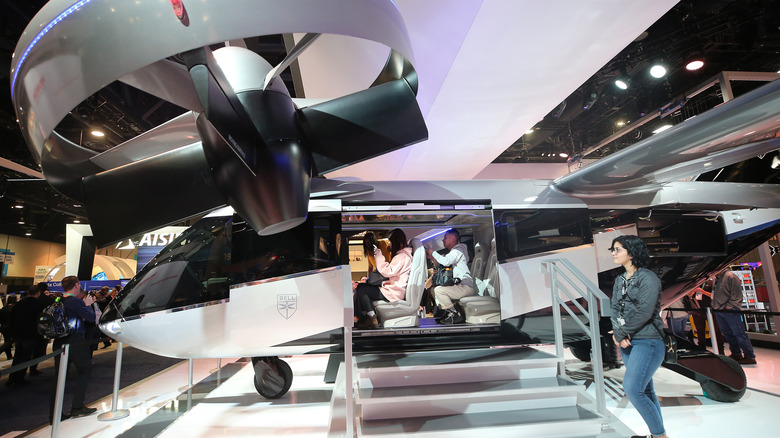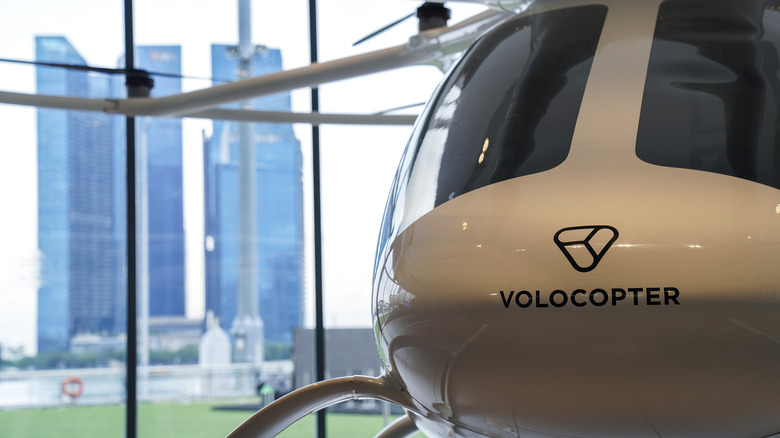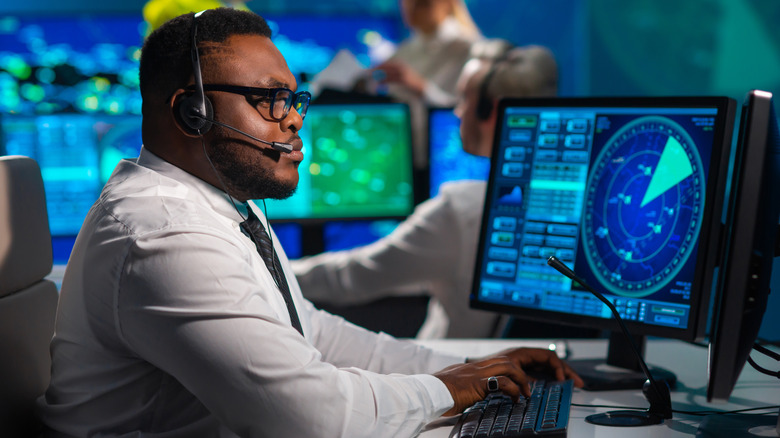Air Taxis Are About To Change The Future Of Travel
Have you ever been stuck in bad traffic and daydreaming about how easy life would be if your car could just fly over the half-mile of honking metal in front of you? Well, those dreams could soon come true, sort of. The solution could be air taxis, which are basically exactly what they sound like: flying vehicles that are capable of taking a small number of passengers on short-range trips. Although it may seem like one of those futuristic ideas that are perpetually five years away, air taxis are already here, and some major companies have bought into the idea.
One of the most recent air taxi acquisitions was by United Airlines. The airline has already put down a $10 million deposit as part of a staggering $1 billion partnership with air taxi manufacturer Archer Aviation. The down payment will go toward the initial 100 air taxis United has ordered. Production on those aircraft is expected to begin in 2023, and the $1 billion deal could see United acquire 200 air taxis in total. In a statement, Archer Aviation CEO celebrated what he called the industry's "first real cash commitment," according to Popular Science.
United isn't the only airline interested in air taxis and the possibilities they might bring. American Airlines and Boeing are also investing heavily in the concept. According to The Wall Street Journal, Boeing is throwing $450 million into a joint venture with Google co-founder Larry Page. If the Boeing/Page effort bears fruit, you could be whizzing around a city in a self-flying air taxi within the next few years. American Airlines has chosen to back Vertical Aerospace, a similar company to Archer Aviation, to the tune of $25 million.
What is an air taxi?
An air taxi is basically a very small plane or helicopter that is capable of taking people on short trips. Unlike a regular taxi, an air taxi won't be picking you up from or dropping you off at your front door. Instead, these aerial vehicles travel between pre-determined destinations that have purpose-built facilities. Do you need to get from the airport to the beach ASAP? Hop in an air taxi, and you'll save a bit of vacation time. Along with Archer Aviation, several companies are developing the vehicles in anticipation of an industry boom; notable names include Bell Flight, Joby, Vertical Aerospace, and Wisk.
Although air travel and the amount of fuel it uses is a favorite target of environmentalists, the chances are air taxis won't find themselves in the firing line. While there probably won't be enough of them available to impact road traffic, air taxis like the Joby Aero won't really be adding to emissions, either. The Joby is electrically powered and can fly an amazing 150 miles on a single charge. In terms of price, taking an air taxi ride isn't going to be cheap and it's hard to see that changing. As with first-class flights, there will certainly be plenty who can afford the trips and will appreciate the convenience. However, most people will probably be sticking to standard taxis, at least for the foreseeable future.
Federal and local regulations may stand in the way
It may look empty if you go outside and stare upward, but the sky is actually pretty crowded, and that crowding also comes with consequences. While car accidents can be very serious, most vehicle collisions are minor, and everyone tends to walk away without injury. If two objects collide while in the air, however, it's a far bigger problem. As a result, everything that takes flight is regulated by the nation whose airspace it is currently inhabiting. In the United States, the agency responsible is the Federal Aviation Authority (FAA), which handles more than 16 million flights per year. That's already a lot, and it's spread over a vast country.
Add a few hundred air taxis to a densely populated major international city like New York, and you have an air traffic control nightmare. Every trip has to be managed to help reduce the chances of a disaster occurring above a major population center. There are already three major international airports in the area and numerous smaller airstrips. While managing the situation may be possible, it's a mammoth task to tackle.
Along with vehicle-based laws relating to the type of aircraft, passenger capacity, servicing, and conditions, there are also rules related to individuals you have to consider. Who is going to pilot air taxis? Will a standard pilot's license do, or would a specialist license be required? How many hours of flight time does someone need before they qualify? There is the possibility of self-flying air taxis becoming a reality one day. In terms of technology, it would essentially just be a large AI-powered drone with passenger capacity. But if you look at the legal hurdles self-driving cars face, it's hard to see their airborne equivalents having an easier time.


